
It is entirely possible to do both a tummy tuck and lipo at the same time.
In fact, lipo can even improve the appearance of a tummy tuck when it is performed at the same time.
This is because lipo can remove pockets of fat that are not visible through tummy tuck surgery.
Plus, some people are afraid of getting a new scar from having too much fat removed from their abdomen.
Therefore, some people opt to remove that extra fat, but they also want to look their best after doing so.
Both procedures are performed under general anesthesia in order to limit any pain that patients may experience.
Tummy Tuck And Lipo – Can you have lipo and tummy tuck at the same time?
Patients may also be given a local anesthetic if they choose to have it.
However, in general, patients should not be on anesthetics for more than five to seven hours.
After tummy tuck and liposuction procedures, patients may experience soreness or swelling around the incision, bruising, and itching.
As with any surgical procedure, there is always a chance of complications after any type of surgery.
One of the most common complications from lipo treatments is infection.
If lipo patients neglect to follow all of the instructions given to them and if they fail to use the recommended medications then they could easily become infected.
Liposuction patients should follow certain post-op instructions in order to minimize any chances of infection.
After performing a tummy tuck, the patient may experience excessive bleeding.
This is usually a normal side effect, as excess fat cells that had been removed during the surgery will start to leak into the abdominal cavity.
After a lipo procedure, patients should expect to see a significant amount of bruising.
This is a normal result of any invasive plastic surgery procedure.
However, the bruising is temporary and can be treated with pain killers.
It is also important to note that lipo is not considered a weight-loss method.
Instead, it is used to remove fat that is not able to be eliminated through diet and exercise, as well as areas of the body that have become enlarged due to obesity or pregnancy.
Some people use lipo to correct the lines and wrinkles on their faces and to make their arms appear flatter.
After performing a lipo procedure, patients may also experience swelling in the area of the fat removal.
This may not be a complication, depending on how large the area is.
It is important for patients to remember that a tuck will not remove the entire excess fat from a person’s abdomen; most patients only need to remove about five pounds.
If a patient has exceptionally large deposits of fat, he may want to consider waiting until the next scheduled lipo session.
If lipo is chosen as a method of removing fat in conjunction with a tummy tuck, both procedures will almost certainly be performed at the same time, rather than on separate days.
This allows the patient to recover completely between procedures, and it also allows doctors to better evaluate the progress of each procedure.
Liposuction is a less invasive procedure than a tuck, but it is still invasive.
Patients who choose either procedure should do all possible to ensure that they are making an informed and educated decision.

Tummy Tuck And Liposuction (What’s the difference)
Many people wonder if there is a difference between a tummy tuck and liposuction.
Quick answer: Yes.
A quick tip: Before deciding on plastic surgery, make sure you are undergoing a tummy tuck or liposuction procedure that will achieve the results you want.
Here’s how to tell the difference between the two surgical procedures.
The difference between a tummy tuck and liposuction can be a matter of inches.
A quick tip: Sometimes plastic surgeons will perform both procedures together.
This does not mean they are identical.
Liposuction is used to reduce the overall volume of the body by removing localized fatty deposits and reshaping the body.
A tummy tuck removes fat from the entire belly region.
Also, used to remove loose skin and thereby tightening all weakened abdomen muscles.
Plastic surgeons who perform these procedures together may be able to create a flatter and tighter stomachs because they use different techniques and use different incisions.
It might be difficult to tell the difference between these two surgical procedures if they have not been done separately.
Does a tummy tuck require an incision?
The surgery involves a large incision along the lower abdomen that starts with a bottom cut.
Also, the belly button tissue is then removed and the remaining skin is stitched back together.
A good photographer will be able to take a photo of your abdomen that shows both the incision and the scar from the surgery.
The pictures you obtain from a tummy tuck and liposuction photo credit should include close-ups of the abdominal area and the newly stitched abdomen area.
If you don’t want a close-up picture, you can choose another photograph for your photo credit.
How long do the procedures usually take?
Tummy tucks usually take about two hours and liposuction can take longer depending on the overall size and shape of your body.
Before having either of these procedures performed you should ensure that you are in the best physical condition and have discussed the risks and benefits with your surgeon.
In some cases, you may experience some bruising after surgery but it will subside within a few weeks.
Both procedures can be performed under local or general anesthesia.
You should ask your surgeon what type of anesthetic he uses for the procedures.
Can a tummy tuck and liposuction remove fat from more than one area?
The two surgical procedures can be used to remove fat from the stomach, hips, thighs, and buttocks.
If you wish to use both surgical procedures at the same time you must make sure that you are in the ideal body weight before having either one of these cosmetic surgeries.
Is liposuction better than a tummy tuck?
Liposuction does a better job at sculpting the abdominal wall because it also eliminates excess skin, which allows the surgeon to achieve more detailed body sculpting.
However, liposuction does not accomplish as much reduction in body volume as a tummy tuck.
Liposuction is also more difficult and requires more postoperative care than a tummy tuck.
What is the recovery time for these procedures?
After either procedure, the surgeon will recommend that you get 5 or 7 days of rest and then about 6 weeks for you to return to work.
You may experience some soreness immediately after having either procedure, but you should not have any lasting pain or discomfort afterward.
The recovery time for both procedures is normally a few days longer than for a normal tummy tuck.
Liposuction patients typically have a shorter recovery time.
How can I be sure that I will benefit from having either procedure?
If you decide to have either procedure you should do your research carefully.
Talk to several surgeons and schedule appointments to talk about the surgery.
You should be able to find someone that is both qualified and experienced to perform either procedure.
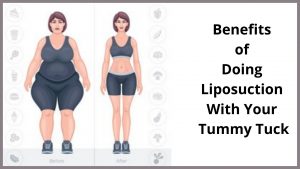
Benefits of Doing Liposuction with your Tummy Tuck.
If you’re thinking about liposuction as part of your body contouring, it’s probably because you’ve seen those stretch marks right along the abdomen.
You may have also experienced some trouble losing weight and getting those abdominal muscles toned up.
Or maybe you just wish there was a way to finally eliminate that cottage cheese-looking belly fat.
Regardless, of your motivation, cosmetic surgeons across America are happy to answer your questions and discuss the benefits of tummy tucks.
The first benefit of having liposuction with your tummy tuck is that it can address both excess skin and excess fat.
Because a liposuction procedure only deals with muscle and fat problems, not skin problems, adding liposuction as part of your overall body contouring can give you more thorough results than just skin removal alone.
In addition to tightening loose muscles and toning your abdominals, liposuction can also help you achieve a flatter, firmer more youthful-looking lower half.
It can also help remove the stubborn leftover skin from a surgical procedure that wasn’t addressed in the initial surgery or from pregnancy.
The second reason to consider tummy tucks is that they can eliminate two potential complications after any type of surgery.
One of these complications is that of excessive bleeding or fluid loss.
Many people become concerned when they see the blood on their own skin after surgery.
While this is a small risk of a tummy tucks procedure, it’s better to be safe than sorry and to use blood thinners or other medications to manage post-op symptoms.
Another consideration for liposuction with your tummy tuck is your weight loss.
After a tummy tucks procedure, you will lose an enormous amount of weight.
This excess skin and fat tissue will be removed and the remaining muscle tissue and fat will be reshaped so that your new abdominal shape is more aesthetically pleasing.
Therefore, it’s extremely important to consult a doctor before having this procedure done.
Any surgeon worth his name will carefully evaluate your medical history, which will include your history of any surgeries and medications you’ve had in the past, to make sure that you’re a good candidate for this type of surgery.
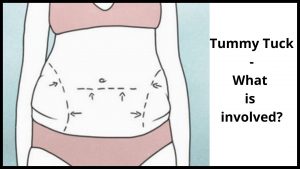
Tummy Tuck – What is involved?
A tummy tuck, or abdominoplasty, is an extensive plastic surgery procedure that tightens abdominal muscles and flattens the abdomen by removing the excess skin and fat.
A tummy tuck will leave you with a flat, slender appearance which gives you a more refreshed sense of self.
It is also referred to as abdominoplasty and a tummy tuck is sometimes referred to as a partial abdominoplasty.
Also, it is major cosmetic surgery and normally requires two separate surgical procedures; one to remove the excess skin and fats and another to create a strong abdominal wall.
Abdominoplastic surgeries are considered to be major cosmetic procedures.
They have been growing in popularity over the past decade and the procedure is more commonly performed on an outpatient basis.
As with any surgical procedure, there are risks of complications and an abdominoplasty tummy tuck is no exception.
While it is rare, some side effects of this type of surgical procedure have been reported.
The most common complication associated with a tummy tuck and one that often occurs is a hernia.
In a typical incision made by a general or abdominal surgeon, the navel is removed in a vertical incision.
If a person has a large pouch of excess skin (which is sometimes called a vesicle) left after the surgery then this must be removed via a “traditional incision”.
Another fairly common complication from a tummy tuck is excessive bleeding from the wound which can sometimes be so severe that it causes further complications.
In extreme cases, the patient may require an operation to repair a hernia.
And in addition to the above-mentioned complications, there is also a risk of infection after surgery and this can be potentially serious as the stomach is opened and irritated.
Excessive weight loss usually leads to a flabby and saggy appearance of the abdomen and can result in low self-esteem.
The cosmetic surgeon who is performing a tummy tuck will take into consideration the amount of excess skin that is removed during the procedure.
During a Tummy Tuck surgery, the excess abdominal area is removed to provide a flat and firm abdomen.
The excess tissue is then removed by making a small incision under the pubic hair area.
A thin tube or a small brush is used to remove the skin.
In order to fix the skin in place a pocket of skin is cut and stitched into position.
Depending on how large the resulting scar will be, your doctor may use either local or general anesthesia.
This can be determined by the doctor you see during your consultation.
Following your Tummy Tuck procedure, you will be given pain medication, rest, and possibly a course of antibiotics depending on the results of your post-operative tests.
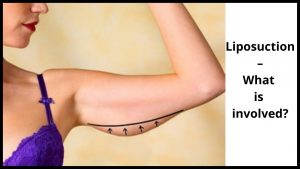
Liposuction – What is involved?
Liposuction is not typically thought of as a weight-reduction method or even a weight-reduction solution.
If you are overweight, you are more likely to shed more pounds through proper diet and regular exercise or via bariatric surgeries including gastric bypass surgery – than you would with simple liposuction techniques.
However, if you do have a bit of excess body fat in certain areas, you might be a good candidate for liposuction as well.
Typically, the entire process of liposuction takes less than three hours to perform and sometimes involves only local anesthesia.
The typical site of the procedure is the abdomen, but it may also be performed on your face, arms, and legs.
Liposuction typically produces a lighter, flatter look for the area that has been treated and some people notice a reduction in the general tone after the procedure.
In general, liposuction is used to treat the excess skin that is retained in the treated areas and also to remove excess fat from between the treated areas.
There are two basic types of liposuction procedures:
One is a tumescent technique in which the fat is soaked up in a saline solution and injected back into the areas of the body that is being treated and another is a laser liposuction technique in which a laser is used to heat up the fat tissue.
Both methods result in the same end results: a lighter, flatter appearance for the treated areas.
The skin is removed using tools that resemble those used to unclog drains – gentle suction is applied to draw the fat out and it is removed with a special device that resembles a surgical tool.
The surgery can also be done under general or local anesthesia, depending on the surgeon’s preference and the medical condition of the patient.
The first steps of liposuction surgery include making small incisions in the skin near the problem area, removing a small amount of fat, and then sculpting the skin after the surgery to give it a contoured appearance.
This allows the plastic surgeons to carry out precise techniques and to tailor the results to meet the patient’s needs.
Most liposuction centers are equipped with experienced and skilled plastic surgeons who perform the surgery.
However, there are some liposuction surgeons who work from their own offices, so before selecting a liposuction center, patients should ensure that they check the surgeon’s credentials.
Anesthesia is provided through an IV.
The surgery typically takes around two hours to perform, and the patient can expect some mild to moderate discomfort, as well as swollen and tender areas.
Pain killers may be provided to control the pain.
As a patient undergoing liposuction, it is very important that you follow your cosmetic surgeon’s post-treatment instructions, which may involve taking prescription medications to avoid infection and minimize side effects.
It is also important to remember that, depending on how much fat has to be removed, some liposuction procedures may cause permanent damage to the treated areas, such as removing too much fat from a large area.
This could result in permanent scarring, and plastic surgeons strongly advise that their patients do not make these kinds of modifications if they don’t want to go through life with that feature being a permanent feature.
In most cases, if the damage caused by liposuction is minor, it will heal itself in a short time.
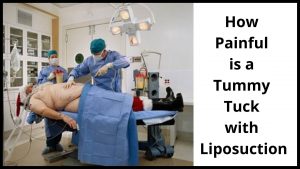
How Painful is a Tummy Tuck with Liposuction?
So how painful is a tummy tuck with liposuction? It depends on many factors.
The most common factor is the patient’s overall health and age.
If the patient is elderly, they are more likely to experience some level of pain.
Liposuction on an elderly person can cause even more serious issues due to their anatomy.
The other factor is the patient’s personal health and exercise habits.
If the patient is inactive, will they be able to physically handle the surgery?
The less active they are, the more likely they will be injured during and after the procedure.
Liposuction takes a fair bit of strength to lift and carry, so a frail person may find that they can barely move after having the procedure.
This can also contribute to the amount of pain experienced after the tummy tuck procedure.
Patients who have had a tummy tuck are at especially high risk for developing post-surgical symptoms.
These symptoms can include nausea, vomiting, fever, chills, fatigue, and general discomfort.
It is important that these symptoms do not prevent you from getting the treatment you need.
Another factor to consider is diet.
If you smoke, chances are your surgery will be more painful.
Smoking impairs recovery and causes damage to the tissues around the incision.
Alcohol consumption is also a problem.
Both smoking and alcohol should be avoided after your liposuction procedures.
Eating after your tummy tuck is also a big concern.
After your liposuction, you will be in need of nourishment to help repair your wounds and restore your body to optimal function.
You should avoid having any salty foods, caffeine, and high-fat foods.
These foods will only make you feel worse after your operation.
You should eat plenty of fresh fruits and vegetables and take multivitamin supplements if necessary
Will you need multiple surgeries to achieve your desired goals?
If you have more than one small tummy tuck surgery performed, you are more likely, to experience post-operative swelling.
And if you have had other surgeries, your surgeon may recommend that you wait to have your second surgery until your swelling is down to a reasonable level.
If you have had multiple tummy tucks, the chances of complications increase greatly.
How long do you plan on recovering from liposuction?
Most people do not need a lot of time to heal from liposuction.
However, if you have significant swelling or bruising, you should rest and avoid moving for a few days after the procedure.
If the liposuction caused excessive bleeding, it should be completely closed using a dressing or bandage.
You should stay away from strenuous exercise for at least a week or two.
What can you do to decrease the pain from a tummy tuck or liposuction?
One of the best ways to minimize pain after a procedure is to use an ice pack before your surgery to reduce swelling and bruising.
An ice pack will numb the area around the incision.
It will also reduce the pain you feel.
Be sure to check with your doctor if you do not feel cold right after your procedure.
After your liposuction, the final results may not be exactly what you expected.
Depending on the type of procedure you have, your surgeon may place your skin back into place.
Some tummy tuck patients need several sutures to hold the skin in place, which can cause additional pain.
Ask your surgeon if you are okay with having your skin re-sewn.
There may also be some bruising from your tummy tuck or liposuction.
Your liposuction could leave uneven skin, scars, or bruised areas.
The bruising will subside as you heal.
If you experience any pain from your tummy tuck or liposuction, it’s important that you report it to your surgeon immediately.
He or she will be able to prescribe pain medications to alleviate your symptoms.
After your tummy tuck or liposuction, you may have soreness and bruising around your incision.
These are normal after any surgical procedure.
It is important that you follow your surgeon’s advice regarding any additional treatments you should take.
They can give you more advice about post-surgical care.
You may experience a strange odor after your tummy tuck or liposuction.
This unpleasant smell is caused by the anesthetic that was used during your surgery.
And this smell typically goes away within a few days, although it may continue for a week or two.
If your tummy tuck or liposuction procedure was a small one, then you may not need an anesthetic.
In this case, you may experience no tummy tuck or liposuction pain after all.
The majority of patients who have a tummy tuck or liposuction will feel an immediate difference in their appearance.
They will look years younger.
A well-done tummy tuck or liposuction will reshape and tighten your body.
You will also look better in a bikini.
However, if your procedure was a bad one, you may still be left with scars and you may have to deal with side effects like excess hair growth.
It is important to make sure that you have a good surgeon before having your tummy tuck or liposuction procedure done.
You want to make sure that you are getting the results you want and that your surgeon is confident in his or her abilities.
Liposuction can be performed under local or general anesthesia, and it usually leaves behind less scarring than a tummy tuck.
Make sure to research your potential cosmetic surgeon carefully and ask for before and after tummy tuck pictures.
You should also ask your friends and relatives what kind of surgeon they would recommend for a tummy tuck or liposuction.
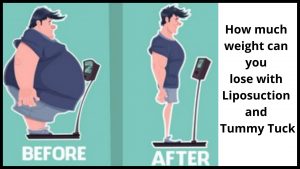
How much weight can you lose with liposuction and tummy tuck?
Liposuction is the name given to a surgical procedure that removes excess fat from the body.
This procedure is also known as Lipoplasty.
How much weight can you lose after liposuction and tummy tuck?
The answer depends on many factors such as your age, your health condition, your goals, and your expectations.
These factors will determine the amount of weight that you can expect to lose.
This answer will depend on many factors.
If you are a good candidate for liposuction, the results can be very satisfactory.
If you do not have a good underlying medical condition that impairs the process of liposuction, it can be performed successfully.
And, If you are a man, a tummy tuck is likely to be more complicated and require larger amounts of fat to be removed than a liposuction procedure.
Men are expected to lose more bodyweight after the surgery than women.
Because men have more muscle mass than women, muscle-intensive liposuction can be more difficult to perform.
Your doctor can give you the information you need to make an informed decision about your liposuction and tummy tuck procedure.
Also, If you are a woman, a tummy tuck is also likely to be more difficult and require larger amounts of fat to be removed than a liposuction procedure.
Women tend to gain more bodyweight than men due to hormonal changes that occur during their menstrual cycle.
A more difficult liposuction procedure may be necessary.
As with any surgical procedure, no matter which one is performed, there is always a risk involved.
Be sure to consult with your cosmetic surgeon if you have questions or concerns about your liposuction or tummy tuck procedure.
Your cosmetic surgeon is an experienced professional who has been trained in all types of cosmetic surgery and knows how to answer all your questions.
The answer to the question should only be decided after consulting with a qualified plastic surgeon.
A surgeon who is well trained and experienced in performing liposuction can tell you the answers to this important question.

Why Is My Stomach Big After Tummy Tuck?
Many patients ask “what causes swelling after a tummy tuck surgery?”
The answer is simple: your body has been greatly injured in the procedure.
And the swelling will usually be present for a few days after your tummy tuck surgery and then it will either go down or stop.
It may even be that the swelling never goes away and stays around for months on end.
Why does this happen and what to do?
1. Lymphatic fluids.
2. Skin has not yet healed completely.
3. Infection.
4. Excessive blood loss.
5. Hematoma.
6. Medications.
7. Large intestine water absorption.
1. Lymphatic fluids.
There are many possible reasons for this, but one of the more common reasons is because the lymph nodes have been damaged during the procedure.
This means that the area now has an excess of lymphatic fluids.
Normally, these are drained during a regular bowel movement but in the case of a tummy tuck surgery, these fluids get reabsorbed into the body.
Because of that, your lymph nodes might get affected in the procedure which can cause swelling.
You need to know what can cause you to have this type of complication in your tummy tuck surgery.
2. Skin has not yet healed completely.
Some doctors recommend that swelling may occur in the first six weeks after the surgery.
This is due to the fact that your skin has not yet healed completely.
This may not cause a problem.
You will not want to rush back into daily activities right away, but rest assured that you will feel better soon.
In any event, the doctor will probably advise you to wait until your wound has healed completely before doing any strenuous activity.
3. Infection.
Another possibility for swelling comes from the possibility of an infection.
Since it is a surgical procedure, there is always a chance that you could become infected.
This is even more so with larger tummy surgeries such as a tummy tuck.
If you are having major surgery like this, you should take all necessary precautions to avoid any risk of contracting an infection.
Be sure to discuss this option with your doctor before the surgery.
4. Excessive blood loss.
Some women may experience excessive swelling.
The good news is that in most cases, this will go away within a few days or a week at the very least.
Excessive swelling after a tummy tuck might be caused by excessive blood loss.
Your doctor may recommend that you use a compression garment to assist in healing and prevent you from experiencing a lot of blood loss.
There is one other thing that you need to be aware of.
In addition to bruising and excessive blood loss, there is also some evidence that suggests that there is a possibility of some infection occurring after tummy tuck surgery.
These can be serious infections like MRSA or some of the types of VDV.
If this is the case, then you need to be extremely careful because they can cause you great pain.
So you need to make sure that you follow all of your doctor’s instructions regarding what to do if you develop an infection.
5. Hematoma.
Another possible cause of excess swelling is a hematoma.
This is similar to swelling that occurs during a surgical procedure.
However, it is also possible for it to be caused by the bruising of the tummy tuck surgery itself.
This is something that you need to discuss with your doctor and possibly get information about how best to deal with it.
It’s also possible that it may be a sign of the side effects that may occur after surgery.
6. Medications.
There are many different medications that can cause swelling after a tummy tuck.
In most cases, the swelling will go away as soon as you stop taking them.
However, you may need to take some anti-inflammatory medication if the swelling lasts for a long time.
Certain pain medications may also lead to some degree of swelling after surgery.
Some doctors recommend a diet of grapefruit, berries, and other foods that are high in antioxidants.
This is because these foods are good at getting rid of free radicals that can damage collagen fibers after surgery.
Drinking plenty of water can also help to reduce the amount of swelling you experience.
In addition, eating foods rich in vitamin C, like citrus fruit and spinach, can also help prevent damage to your skin from free radicals.
7. Large intestine water absorption.
The other big reason why the stomach becomes big after a tummy tuck is a fact that the large intestine has not been able to absorb the amount of water and other liquids that the large intestine used to absorb.
When the large intestine fails to do its job properly then this leads to the blockage of the small intestine.
If the blockage is not sorted out then the small intestine will not be able to absorb the liquids that it needs.
This will ultimately lead to bloating and the protrusion of the large intestine.
What To Do.
In the case of swelling due to tummy tuck swelling, there are some things you can do to help reduce it.
One is to drink plenty of water.
You should also avoid lifting heavy objects.
The last thing you can do is to use a cold compress where you apply it to the swollen area.
This will reduce the swelling due to tummy tuck surgery.
No matter what type of tummy tuck surgery you have gone through, you are going to experience some swelling after the procedure.
You need to understand that you are going to have to accept this fact.
Your doctor is going to want to limit your movements for a period of time after the procedure.
You will not be allowed to do much at all.
This will be your first experience after a tummy tuck surgery.
Hopefully, it will end the same way as everyone else’s does.
After surgery, swelling due to tummy tuck swelling normally goes away within a few days.
However, sometimes this can take longer.
It is important that you follow all of your doctor’s advice and check on your swelling often for a few days after surgery.

Can You Gain Belly Fat After A Tummy Tuck?
Can you gain belly fat after a tummy tuck? Yes, you can gain weight if you choose to.
If you have a strong healthy abdominal area, then the answer is yes.
Also, If your abdominoplasty was a small procedure, then you may be able to return to your former size.
And If your surgery was a larger procedure, you may need to go on a diet and exercise program to change your body to the shape you want.
You will have to change your lifestyle if you want to permanently change your life after a tummy tuck procedure.
A tummy tuck is a great procedure that can give you the shapely body you have always dreamed of.
The only thing holding you back from a great-looking tummy tuck is your mind; be prepared to work hard to get your body to look the way you have always dreamed it.
Also, there is a chance you will gain a small amount of weight as your body repairs itself and gets accustomed to the new position.
The repair of the skin will slow the rate at which fat is lost.
You may gain a small amount of weight in the first few months as your skin heals and you heal.
Also, you will likely not gain more than a couple of pounds in the first year, but the final results will be a much firmer and tighter stomach.
People who have abdominoplasty procedures may struggle to lose weight after their operations.
The reason for this is simple: regardless of how much fat is removed from the tummy, new fat cells may still form.
That’s why Liposuction is used to permanently eliminate excess fat from the waist and sculpt the underlying abdominal area.
If you have the money to go through such a procedure, then by all means go for it.
And if you have reasonable expectations about the results, however, you may want to reconsider getting a procedure done.
For this reason, people who want to eliminate unsightly belly fat after a tummy tuck should instead look to lose the extra weight through diet and exercise.
Although tummy tucks are often recommended for patients who are extremely obese, losing just 5% of your body weight in a year with surgery can still be dangerous.
Also, if you stop following a healthy diet and lifestyle, you may undo the work done by your surgeon.
Don’t lose heart if you think you have fallen into this category.
Tummy tucks aren’t a solution to weight loss, but a surgical procedure is.
The best solution to weight loss after a tummy tuck is to make some healthy changes in your lifestyle.
You can lose weight by eating a healthy diet with plenty of fresh fruits and vegetables and exercising.
When you make these changes, you will also notice that your waist will begin to slim.
So, if you want long-term results, it is important to continue to eat healthy even after having your surgery.
Generally, when individuals lose weight from a cosmetic/elective point of view, they usually only lose some belly fat initially.
Then, after a while, they see a bit of weight loss.
This is normal since it takes time for the body to adjust to changes in weight.
However, it is also possible for tummy tucking to cause long-term, permanent belly fat.
If you do not do something about the fact that you lose after your operation, soon you will be gaining it back.

Why Is My Belly Not Flat After Tummy Tuck?
Abdominal muscles can contract.
It is very possible that during the tummy tuck, large scar tissue could develop.
If this scar tissue was not removed properly during the tummy tuck, it may prevent the abdominal cavity from healing properly and could cause a second bulge to form.
In such cases, the newly acquired belly button will not look as flat as the original one.
Likewise, the abdominal cavity expands and contracts as part of the body’s metabolism.
After having a tummy tuck, the abdominal cavity may have been stretched a bit or more.
It may now be evident that the new contour of the abdominal cavity is not straight and may not exactly resemble the original contours.
This extra volume will cause the belly button to protrude.
There is also a possibility that the newly acquired horizontal abdominal crease may overlap with the horizontal crease of the belly button.
In the absence of proper post-surgery care, the newly acquired bulges could cause a bit of horizontal scarring and protrusion above the horizontal line of the abdomen.
Such vertical protrusion below the horizontal line in the abdominal cavity after a tummy tuck could cause serious aesthetic problems.
And such protrusion could cause the lower part of the abdomen to stick out even more.
Such cosmetic problems could easily be corrected through proper post-operative abdominal support and care.
Abdominal contents made up the majority of the abdominal cavity before the tummy tuck operation.
There is a good chance that these contents are not all properly positioned in the abdominal wall.
These could make the abdomen seem flattered after the surgery.
That is why the abdominal cavity may have expanded beyond the extent of the incision and could look as though it has been stretched or pulled.
If the abdominal contents are not correctly positioned after the tummy tuck, there is a strong chance that the abdominal cavity will not close after the surgery.
The incisions will again have to be re-stitched and the excess skin and fat will have to be removed through a process called liposuction.
This can cause a number of aesthetic problems for the patient.
For instance, if the excess skin and fat are removed, too easily, the abdomen may develop stretch marks that resemble large scars.
Tummy tuck or abdominoplasty surgeries are major medical procedures.
When you are fully healed from surgery, you will be in a state of high anticipation and excitement.
As long as you have fully recovered from your surgical procedure, your doctor will guide you on how to properly care for your newly acquired belly.
This is due to the fact that abdominoplasty surgery will involve repositioning your lower abdomen, tightening or removing your abdominal muscles and fat deposits.
Once the skin is repositioned, you can expect to see improvements in your appearance in terms of your overall appearance and the contour of your abdomen.
The amount of excess fat and skin will be gradually removed.
Some doctors recommend that the abdominal muscles are tightened before the surgery.
This is necessary because once your muscles have been tightened, they will be less likely to sag.
And this will result in your remaining skin being flatter around your midsection.
However, if you do not want to undergo a tummy tuck, then you have other options to get rid of your unsightly belly fat.
Many cosmetic surgeons have reported great success in their surgical attempts to tighten the stomach.
Some of these procedures can be done under a general anesthetic, while others may require a local anesthetic.
Either way, you can expect to get rid of your problem in as little as three to six months.
The most common type of surgery that is used to treat abdominal muscles and fat deposits resulting from pregnancy is called liposuction.
After the tummy tuck, your abdomen will probably be swollen, making liposuction an attractive way to get rid of stubborn fat.
In addition, liposuction does not require a lengthy recovery period, unlike some other surgical procedures.
You can return to work and to your normal activities within two weeks of surgery.
Liposuction, on the other hand, is designed to suck out pockets of fat located in the middle of the abdomen.
Liposuction helps eliminate the stomach’s undesired fat pockets because it forces them to lie closer together.
The patient will experience minimal discomfort during the surgical procedure and will recover much faster than a tummy tuck or liposuction.
Unlike tummy tucks, liposuction requires minimal incisions, injections, or staples.
This makes it an ideal choice for patients who are not keen on having a scar at the lower abdomen.
Abdominal muscles can also be tightened using tummy tuck exercises.
These exercises are sometimes performed along with the surgery.
As with liposuction, they do not cause much scarring and recovery time.
However, they do not improve overall contour and appearance as quickly as tummy tuck surgery.
And, some people prefer them because they feel less pain and worry less about their appearance after having the surgery.
Another option for tightening abdominal muscles after a tummy tuck is to use the vaser or laser ablation technique.
This procedure uses electric currents to burn unwanted fat deposits.
While it does not improve the shape or quality of your abdomen, many people who undergo this choose to have the procedure to improve their self-esteem.
You do have other options to address the question of “Why is my belly not flat after a tummy tuck?”
If your abdominal muscles are too weak or just starting to sag, you may need to lose weight.
You may want to consider doing leg lifts to strengthen your core muscles.
Losing even 10% of your body weight can make a dramatic difference in the way your tummy looks.
After a tummy tuck, your body will store fat in those areas permanently. But, It is your responsibility to lose them.

Conclusion:
A lot of people want to know if it is possible to perform a tummy tuck and lipo at the same time.
You can, but there are certain things that you need to know.
First off, there is a big difference between liposuction and tummy tuck surgery.
Lipo is generally reserved for those who have loose skin or sagging skin in general, whereas tummy tuck is considered to be a much more serious operation.
The best way to compare the two is with an example.
Suppose you wanted a tummy tuck to tighten up your abdominal area.
You would probably need to perform a traditional abdominoplasty, where you would go in and perform what is known as an abdominoplasty, which essentially is just a tummy tuck.
However, there is a lipo tummy tuck that you can also get, and this type is called a lipo tuck combined with a traditional abdominoplasty.
This is great news for those wanting either a tummy tuck or lipo at the same time.
What you will need to do, then, is to decide which one you would like best.
Some doctors may even be able to perform both at the same time for you.
If you do this, it is important to know how much fat (if any) you still have in the abdominal area.
Some surgeons will only perform the lipo if there is still some fat to be removed from around the waist.
